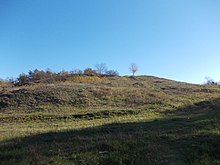Fire mountains
The fire mountains are a 92-hectare nature reserve in the conservation area " Saale valley ". According to the Fauna-Flora-Habitat Directive , the area is a designated protected area in nature and landscape protection . The Brandberge are located in the federal state of Saxony-Anhalt , in the northwestern urban area of Halle , between Kröllwitz and Heide Nord, on the edge of the Hercynian dry area and are important for the climate of the city of Halle due to the cold air flow directed north-north-east.
use
In the 1930s it was a popular winter sports area. After the Second World War until the end of 2007, the Brandberge was used as a military training area by the Soviet military , the NVA and the German armed forces . During this time, flora and fauna were able to develop largely undisturbed. In 2004, 40 hectares of the area were auctioned off to private individuals in Halle for 37,000 euros. Today the area is used exclusively as grazing land for sheep.
geology
The Brandberge consist of porphyry dome complexes with strong relief and flat areas in the direction of the neighboring Saale . In the central area of these porphyry dome there are remains of ancient tertiary kaolin bark and tertiary sediments . Between the Hechtgraben in Halle and the Saale, a dry subsoil made up of gravel deposits has formed, with cohesive cover layers in some cases.
flora
The area is characterized by dry and semi-arid grasslands and dwarf shrub heaths on porphyry hilltops, small bodies of water and reed beds, quarry forest, boggy locations, ruderal areas and poor arable land. There are species of plants that are worthy of protection, such as the common crucifer, the common pasque flower, the cuckoo carnation and the common water cockfoot . There are also endangered plant communities such as B. Euphorbio-Callunetum, Thymo-Festucetum and Filipendulo-Helictotrichetum.
fauna
In the fire mountains are numerous types of found amphibians and reptiles such as toads , newts and grass snakes . Waders and songbirds use the area as a breeding ground. Birds of prey use the arable land to procure food and there is an extremely diverse insect fauna throughout the area .
The thing place
On April 30, 1934, the NS - Thingplatz Brandberge was completed as the "first thing place of the Reich". The construction was carried out according to plans by the architect Ludwig Moshamer and was managed by Walter Tießler and Wilhelm Jost . Among other things, a thing square with 5,050 seats was built on an open-air stage measuring around 100 by 100 meters, using porphyry mainly found in the region. The Thingstätte is on Halle's list of monuments, but due to decay and overgrowth, it is hardly recognizable today. The Thingstätte also included six larger-than-life worker statues made of red Löbejun rhyolite (quartz porphyry) by the sculptor Alfred Vocke , which were considered worth preserving in the GDR despite their National Socialist past and were set up at Halle's Kurt Wabbel Stadium . After the demolition and renovation of the Kurt Wabbel Stadium, the listed outer wall with the worker statues was integrated into the newly built natural gas sports park .
Individual evidence
- ↑ Brandberge in private hands , Mitteldeutsche Zeitung of February 17, 2004, accessed on June 25, 2015.
- ↑ Cornelia Schmitz-Berning, Vocabulary of National Socialism , 2nd edition, de Gruyter, Berlin; New York 2007, ISBN 9783110195491
- ↑ Rainer Stommer, The staged national community. The Thing Movement in the Third Reich , Jonas, Marburg 1985, ISBN 3922561314
- ↑ Dr. Walter Müller, “Germany's first thing place on the Brandberge”, in: Sonntags-Nachrichten, Halle (Saale), 19th week, 16th year of May 10, 2009
Web links
- Nature reserves in Saxony-Anhalt
- Information about the nature reserve on Halle.de
- Info on the nature reserve (pdf) (73 kB)
- Information on the highly endangered plant communities
Coordinates: 51 ° 30 ′ 35 " N , 11 ° 55 ′ 41" E



